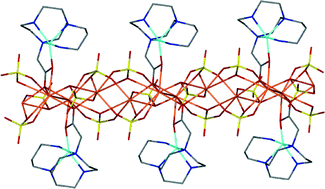The synthesis, structure and properties of copper(ii) complexes of asymmetrically functionalized derivatives of 1,4,7-triazacyclononane
Abstract
Reaction of 1-propylamino-4-acetato-1,4,7-triazacyclononane (L1), 1-benzyl-4-acetato-1,4,7-triazacyclononane (L2) and 1-benzyl-4-propylamino-1,4,7-triazacyclononane (L3) with a copper(II) salt gave Na2[CuL1](ClO4)3 (1a), [CuL2]Cl (2) and [Cu2L32](ClO4)4·5H2O (3), respectively. [CuL4]ClO4 (4) was formed by reacting 1-formyl-4-ethylacetato-1,4,7-triazacyclononane with cupric chloride in aqueous solution. The X-ray crystal structures of the complexes reveal that the ligands generate distorted square pyramidal or square planar coordination environments about the Cu(II) centre, but in three complexes (1b, 3 and 4) weak interactions to an oxygen atom from a perchlorate anion and, in the case of 4, also to an amide nitrogen leading to tetragonally elongated octahedral Cu(II) geometries. In 4, the formyl group is found to reduce the coordinating ability of the macrocyclic nitrogen to which it is attached, as evidenced by the weak Cu⋯N interaction. The formation of five-membered chelate rings on coordination of the ligands further contributes to the distortion from the ideal geometries. The crystal lattices contain a number of novel supramolecular features. 1a contains a negatively charged sodium perchlorate chain of composition [Na2(ClO4)3]xx−, with a complex series of Na–O–Na bridges flanked by [CuL1]+ units, while 3 contains highly complex hydrogen bonded sheets approximately 20 Å thick that stack through van der Waals interactions. One-dimensional chains comprised of copper complexes are found in 2 and 4, and are held together by hydrogen bonds in 2 and acetate bridges between the copper cations in 4. The solution EPR spectra indicate that the copper(II) centres exist in isolated distorted square pyramidal (possibly square planar for 4) environments, while in the solid state there is evidence for the existence of weak exchange and dipole–dipole coupling for some complexes.


 Please wait while we load your content...
Please wait while we load your content...